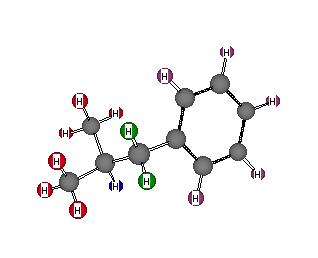 |
|
|---|
Formula: C10H14
Answer: Isobutylbenzene
Chemical Shift Assignments:
1H NMR: δ 7.61 (5H, m), 2.89 (2H, d, J = 7 Hz), 2.29 (1H, nonet, J = 7 Hz), and 1.34 (6H, d, J = 7 Hz)
13C NMR: 141.8, 129.4, 128.4, 126.0, 45.8, 30.5, and 22.7 ppm.
The degree of unsaturation is 4. The 13C spectrum shows only 7 of 10 carbons. There are 3 pairs of identical carbons. The doublet in the 1H spectrum at δ 1.34 is two equivalent methyl groups coupled by 7 Hz to a single hydrogen, the one at δ 2.29. This gives us (CH3)2CH-. Since the signal at δ 2.29 is a nonet with J = 7 Hz, it must be coupled to eight other protons. We have accounted for six, so the remaining two are at δ 2.89. Now we have (CH3)2CHCH2-, (C4H9). This isobutyl group has two equivalent methyl groups. The residual formula is C6H5, which must contain the four degrees of unsaturation. The chemical shift of these five hydrogens suggests a phenyl group as does the appearance of only four different carbon singlets in the aromatic region of the the 13C spectrum. Return to Menu.